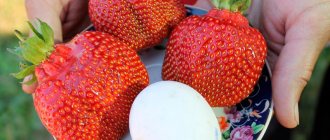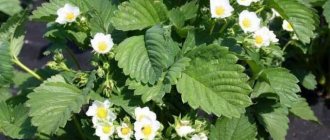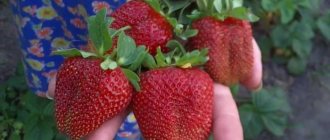At the mere mention of strawberries, the unusually pleasant taste of summer and the sweet aroma of berries immediately comes to mind. It’s a pity that strawberries bear fruit only a couple of weeks a year, because they are considered one of the most delicious garden berries. Recently, remontant varieties of garden crops, capable of producing several harvests per season, have become increasingly popular, but not every owner wants to get involved with this new product. To prolong the enjoyment of fresh berries, gardeners grow varieties with different ripening periods. One of the latest species is the Borovitskaya strawberry, which ripens only at the end of July. This late-ripening variety has a big plus - the excellent taste of the berries, but it also has its disadvantages.
A detailed description of the Borovitskaya strawberry variety, photos of bushes and berries, as well as reviews of gardeners who grow it on their plots can be easily found in this article. It also provides brief instructions for growing late-ripening garden strawberries and some tricks for caring for them.
History of the variety's creation
Strawberry Borovitskaya is a variety of Russian selection, it was bred by breeders from the All-Russian Selection and Technological Institute of Horticulture and Nursery Growing. When breeding it, such well-known varieties as Nadezhda and Redgauntlet were crossed. In 1992, Borovitskaya strawberries were grown in experimental plots and tested. And this strawberry variety was added to the State Register of Russia only in 2003.
Borovitskaya strawberries were recommended to be grown in the Volga-Vyatka and Far Eastern regions, including in the following areas:
- Kirovskaya;
- Sverdlovsk;
- Nizhny Novgorod;
- Sakhalinskaya;
- Magadan;
- Amurskaya;
- Kamchatskaya.
Strawberry Borovitskaya - photo
You can also grow this variety in the following areas:
- Perm;
- Primorsky;
- Khabarovsk.
INTERESTING!
The best strawberry varieties for Siberia
Strawberry Borovitskaya: main characteristics and description of the variety
This strawberry variety is practically the latest among all varieties bred in Russia and abroad. In the Moscow region, the harvest from the Borovitskaya strawberry plantation is harvested only in the last days of July, and in the south of the country - a month earlier.
Strawberry bushes of this variety are of medium size, they are erect and medium spreading. A lot of foliage is produced, it is large in size, medium wrinkled, dark emerald in color.
A lot of mustaches form, so some of them have to be removed regularly
so that they do not take nutrients “on themselves” when fertilizing is so necessary for the ripening of berries.
Photo of Borovitskaya strawberry
Peduncles are thickened, long, with slight pubescence, growing above the leaves. Flowers on peduncles are formed of male and female types, so this variety does not require additional pollinators. The flowers are collected in inflorescences, each of which can form 5-6 ovaries. The flower stalks do not lie on the ground even under the weight of ripe berries, but experienced gardeners recommend placing supports under the flower stalks during the period of berry ripening.
The berries of this variety set well. Borovitskaya strawberry is considered large-fruited - the weight of the berries is 38-40 g
. The fruits have a regular cone shape with blunt tips and a wide base. The fruits have no neck.
The first ripening berries are the largest, but they often grow together and therefore can take on irregular shapes. Voids often appear inside the pulp of such fruits. And fruits weighing less than 35 g have a regular, beautiful shape and do not have voids inside.
Not fully ripened strawberries have a brick-red color; when fully ripe, the berries become cherry-red.
Garden strawberry (strawberry) Borovitskaya - video
The pulp is compacted, but with a lot of juice, its color is soft red. Borovitskaya strawberries have a pleasant taste - sweetish with slight sourness and a strong strawberry aroma.
The separation from the stalks is dry.
On a note!
But experts do not rate the taste qualities of the fruits of the Borovitskaya strawberry variety very highly - their tasting score is only 4 points out of 5 possible.
This late-ripening berry crop is classified as a dessert crop, so the collected fruits are used for fresh eating and for preparing various desserts, as well as jam and marmalade, marmalade, and frozen for the winter.
Borovitskaya strawberries are highly resistant to frost - they can withstand temperatures down to -34 degrees Celsius when covered only with a layer of snow.
Treatment against diseases and pests
According to the description, Borovitskaya strawberries demonstrate resistance to diseases characteristic of the crop, but this factor does not eliminate the risk of infection.
Common diseases:
- Gray rot. This problem can be diagnosed by brown spots with a gray coating on the foliage and fruits. Treatment involves the removal and subsequent destruction of all damaged parts of the plant. To combat the fungus, spray the bushes with a solution of potassium permanganate or iodine.
- Powdery mildew. The disease manifests itself as a white coating on the leaves, which later acquires a bronze color. Severe infestations require plant treatment with fungicides.
Nematodes and strawberry mites are considered dangerous pests for the Borovitskaya strawberry variety. They mercilessly destroy plants, feed on roots, leaves, and some of them prefer to feast on fruits; in addition, they are carriers of dangerous diseases. Control such parasites by treating the bush with insecticidal and acaricidal preparations.
When using chemicals, you must follow the application rates prescribed in the instructions and the timing of the last treatment before harvesting.
Advantages of the variety
The main advantages of the Borovitskaya strawberry variety include:
- thanks to the late ripening of fruits, gardeners are able to extend the strawberry season almost until the end of July;
- flowers bloom late, when spring return frosts have already ended;
- a large number of ovaries are formed on the bushes;
- the berries ripen quite smoothly;
- bushes are able to tolerate heat, drought, high soil and air humidity;
- high frost resistance;
- with proper care, the yield of this variety is quite decent;
- the second wave of the harvest has excellent presentation and taste;
- the high resistance of this strawberry plantation to most diseases characteristic of other strawberry varieties.
Among the disadvantages of Borovitskaya strawberries, only the main ones should be noted:
- not too high yield, which is why this variety cannot be grown for further sale;
- fully ripened fruits are too soft and juicy, so they do not tolerate transportation even over short distances;
- at the stage of incomplete ripeness, the berries are not too sweet, so the taste of the fruit is far from truly dessert.
Important!
With increased soil moisture, this variety continues to bear fruit as usual, but the bushes may be affected by gray rot.
Review
Svetlana Viktorovna
As for me, the mediocre yield stated in the description of the Borovitskaya strawberry variety is greatly exaggerated. This variety of garden strawberries has been growing at our dacha for many years, and all these years Borovitskaya has been pleasing us with stable and abundant harvests. A couple of dozen bushes are enough for a small family to thoroughly enjoy the taste of the last strawberries of the year. The most surprising thing is the unpretentiousness of the variety. Strawberries can grow in any climate and on any soil; the only thing it really needs is generous feeding.
Borovitskaya garden strawberry: rules for planting and propagation
To get good yields from the Borovitskaya strawberry variety, it is important not only to plant it correctly and then take good care of it - it is also important to choose good, healthy seedlings. Healthy seedlings should have a root collar with a diameter of at least 5-6 mm, 5 bright green leaves, a whole apical bud and healthy white roots about 4 cm long.
Rules for planting strawberries and wild strawberries - video
Before planting, it is recommended to keep the Borovitskaya strawberry seedlings in a cool place for two days, which increases the plant’s resistance to external adverse weather conditions in the future.
. Before planting, the roots are slightly trimmed and treated with any growth stimulant.
On a note!
You can plant Borovitskaya strawberries both in spring and autumn, but for better survival rate it is recommended to plant rosettes of this variety in the last ten days of August or early September.
The area for planting this variety of strawberries should be well lit by sunlight, protected from gusts of cold wind and strong drafts. The soil for planting should be well fertilized and loose; it is best to plant strawberries on black earth or loamy soils. Groundwater should not approach the earth's surface closer than 1.0 m.
Beds for planting Borovitskaya strawberries in open ground are prepared in advance: all plant residues are removed along with roots, at least 7-8 kg of organic matter is added to each square of area, and digging is carried out. The soil for spring planting is prepared in the fall. When planting strawberry seedlings at the end of summer or autumn, the beds should be prepared 25-30 days in advance. This is necessary so that the soil has time to settle before planting the plants, otherwise their root system may be exposed.
Borovitskaya strawberries are usually planted using the strip method.
, while the distance between adjacent plants in a row should be about 0.35 m, and between ribbons - about 0.7 m.
Water is poured into the prepared holes, after it is absorbed, seedlings are placed in the holes, the roots are straightened and the holes are sprinkled with soil. It is compacted, then the bushes are watered, then the ground around the bushes is mulched with organic matter.
Plants should be planted in cloudy weather
. If it is hot, then in the first week after planting it is better to shade the bushes so that they acclimatize normally.
Landing
The time for planting a plantation should be chosen so that the air temperature is not too high. In central Russia - mid-April or early September. In the south - end of March, mid-October. In autumn, planting must be completed about a month before the onset of frost, so that the rosettes have time to take root, otherwise they will simply be pushed out of the ground.
The most sunny site is selected, with deep groundwater (at least 70 cm from the surface of the earth). To ensure uniform illumination of the bushes, the beds are laid from north to south. Borovitskaya will grow well on fertile light loams with an acidity level of pH 5.5-6.0.
In order for Borovitskaya seedlings to take root well and grow quickly, high-quality feeding is initially needed. A month before planting the plantation, the site is dug up and humus is added at the rate of 1 bucket per 1 square meter. m and wood ash 1 cup per 1 sq.m. Alternatively, you can add organic matter and ash directly into the wells.
In regions with cold winters, where you need to cover the bed with agrofibre, it is more convenient to plant bushes in 3-4 strips:
- between plants 30 cm;
- 40 cm between strips.
After planting, the bushes are immediately watered, the root zone is covered with hay and sawdust. When planting, make sure that the root collar (heart) remains at ground level.
Strawberry Borovitskaya: further care
When organizing the care of Borovitskaya strawberries, you need to pay close attention to compliance with the irrigation regime.
. Although this variety tolerates periods of drought and heat well, without abundant and regular watering the berries can become smaller, and voids can form in the pulp.
It is necessary to water as the soil dries out, especially often during the flowering period.
Water should be applied only at the root, avoiding drops of moisture on the foliage and flowers - this can provoke the development of gray rot.
Strawberries negatively perceive the appearance of weeds in the beds, so after each watering it is necessary to loosen the soil while simultaneously removing weeds.
Fertilizing strawberry bushes Borovitskaya
Despite the fact that when planting Borovitskaya garden strawberries, all the necessary fertilizers were applied to the bushes, in the future during the summer season these berry plants need to be fertilized three times.
Feeding strawberry bushes
After the snow melts and the soil warms up to 13-15 degrees Celsius, ammonia fertilizers are applied under the strawberry bushes.
During flowering of a strawberry plantation, it is better to carry out foliar feeding. To do this, prepare a solution based on mineral fertilizers containing N, K, P, Ca. This treatment is repeated during the active formation of ovaries.
How to care for strawberries
A photo of ripe berries of the Borovitskaya variety will not leave anyone indifferent: the strawberries are very large, cherry-red, glossy, even. In order for the harvest to please with abundance and quality, the gardener will have to work hard - the large-fruited late variety loves good care.
The stages of caring for strawberry beds should be as follows:
- The most important thing is feeding. Like any large berry, Borovitskaya needs careful nutrition. In addition to the initial fertilizer at the planting stage, the beds are fed at least three times each season. In early spring, as soon as the snow melts and the earth warms up at least a little, ammonia fertilizers are applied. It can be a primitive nitroammophoska or a more expensive complex fertilizer - there is not much difference. At the flowering stage of strawberries, foliar fertilizers are needed - these are complexes diluted in water with a small portion of nitrogen and a good portion of calcium, phosphorus, and potassium. During the ovary period, foliar spraying of the bushes with the same fertilizers is repeated, focusing on the mineral components and reducing the amount of nitrogen. At the end of the season, after the last harvest, a mineral complex is added to the soil and humus is scattered around the strawberry bushes. Such feeding is needed to restore the strength of large-fruited strawberries and stimulate yields next year.
- The Borovitsky variety tolerates drought well, but this strawberry also needs water. Strawberry beds should be watered regularly; special attention is paid to the bushes during the flowering period. In order not to provoke infection of strawberries with gray mold, water the plants at the root, trying not to wet the leaves and berries.
- Borovitsky strawberries are resistant to diseases and pests, but it is better to treat them with preventative agents. This can be either a special chemical composition or one of the traditional methods (wood ash powder, laundry soap solution, etc.).
- Any weeds contribute to the proliferation of infections in strawberry bushes, so the grass should be removed regularly. The beds themselves are loosened and weeded after each watering. To make life easier, gardeners can mulch their strawberry rows with peat, straw or sawdust.
- Many gardeners mow strawberry tops before the onset of winter cold. In the case of Borovitskaya, this should not be done - all the forces of the plants will be spent on restoring green mass. It is quite enough to walk through the rows and clear the bushes of dry, diseased leaves, rake out debris from them, and remove weeds.
- Frost-resistant Borovitsky strawberries, as a rule, are not covered for the winter. If this is still necessary, it is better to use pine needles or agrofibre - viruses and bacteria do not multiply in these materials. As soon as snow falls, it needs to be collected in the strawberry beds, trying to create a shelter about 20 cm thick.
- Propagating the Borovitsky variety is easy and cheap - strawberries produce a lot of tendrils that take root well, creating many rosettes.
Advice! If the gardener's goal is to propagate the variety, the flower stalks need to be removed, sacrificing yield for the sake of a large number of strong runners. In other cases, it is necessary to cut off the tendrils, because they draw strength from the plant, which affects the number and size of strawberries.
Borovitskaya strawberry: reviews from those who planted and grew the variety
Svetlana, 45 years old, Moscow region: I constantly look after Borovitskaya strawberries, so the yield of this variety may be higher than stated. One bed of these strawberries is enough to feed my whole family. Strawberry Borovitskaya is unpretentious in care, but loves regular feeding.
Natalya, 50 years old, Sverdlovsk region: Borovitskaya strawberries grow and bear fruit well in our region. For the winter, I still cover it with non-woven material, because winters in our region can be too frosty. But even if the bushes freeze a little, they quickly recover next season. I really like the appearance and taste of ripe Borovitskaya strawberries, but one thing is bad - they are practically not transportable. Therefore, I make all the strawberry preparations at the dacha, and only transport jars of strawberry jam to the city.
Borovitskaya strawberry is not suitable for growing on an industrial scale due to its not very high yield, but for growing in garden plots this variety is one of the best among the late-ripening varieties of this berry crop.
Recently searched:
Reproduction
Reproduction of the Borovitskaya variety cannot be called difficult, since strawberries produce a sufficient number of tendrils. The horns take root well and grow quickly. During the summer, from 3-5 bushes you can collect up to fifty planting material. Peduncles from the mother bushes are cut off so that the plant’s strength is directed only to the formation of planting material.
It is possible to propagate strawberries by dividing the bush into 2-3 parts and using seeds. However, it must be taken into account that seed propagation is a long and labor-intensive process, and division does not always lead to complete survival.











